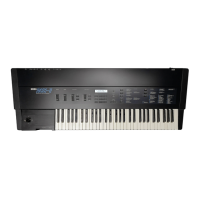■ While the sampling frequency determines the resolu
tion regarding changes over time, there is also the
matter of the resolution of the signal level of each
sample taken. We call this A/D (analog-to-digital)
resolution.
The DSS-1 has very high A/D resolution to assure ac
curate quantization and, therefore, high fidelity.
• How A/D resolution relates to sound quality.
Here we have the same waveform recorded at 6-step
resolution and 16-step resolution.
■ The DSS-1 lets you choose any one of four sampling
frequencies, at 16kHz, 24kHz, 36kHz, and 48kHz.
Make your choice based on your need for high range
harmonic detail. Sampling at 16kHz creates consi
derable distortion which you may want for some ef
fects.
Here we have only
a rough approxima
tion of the input.
Here the result
is closer to the
original.
• What happens to sound quality at the 16kHz sampl
ing frequency?
Here we have the same sound recorded at two dif
ferent sampling frequencies.
i) Sampling at 32kHz.
These squared off steps are
The steps appear as audible
; harmonics, producing a kind
of distortion.
■ The DSS-1 uses 4096-step A/D resolution to assure
extremely fine representation of the signal level of
each sample. These steps are represented in wave
m em ory as values from - 2 0 4 8 to +2047.
• A/D resolution for sampling in the DSS-1.
This provides very
fine discrimination
between different
signal levels.

